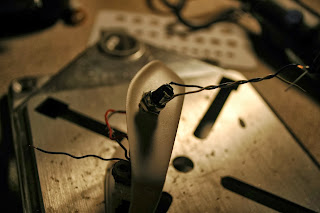You might be familiar with this "mod" on gaming communities, whether it be for Xbox games or for computer games. Basically you add a 555 timer sends an oscillated signal to a button to simulate extremely fast clicking.
This is my old mouse
I found an awesome wireless mouse in Hong Kong that only costed $5, and I loved using it. It was more sensitive, and, wireless! My desk was beginning to get cluttered so I was more interested into going wireless.
The bad thing is, it doesn't have this rapid-fire button on it.
The 555 timer runs at 5v. If I tried to put that circuit into a mouse running at 1.5v, I would have a bad time.
I dug the internet for solutions to this problem, and found nothing. I have yet to find a web page that has instructions on how to build a rapid fire circuit for a wireless mouse, or even proof that it has been done.
The only thing I found was this. Sad.
Apparently, TI sells and low voltage variation of the 555 timer, the LMC555. It's CMOS, so it runs with less power.
TI claims that it has this swap-out property, so I can just replace a normal LM555 with a LMC555 and everything will still work. I had to see this for myself.
So I ordered a few and built the circuit as I always would. Here is a schematic
So the first step is to take apart the mouse.
Good job!

Test it
You should get this really quick square wave.
Now you are going to have to do a little testing (with a multimeter)on the mouse now.
Most wired mice have a button that when you click it, it shorts HIGH to the processor. When the processor picks up the HIGH, it takes it as a click.
This wireless mouse does something else. When the processor senses that a pin is LOW, it considers it a click.
From the two button pins, find the pin to the processor (2-3v) and the pin that is LOW (0v).
Test each lead of the button.
To find out whether your mouse is activated by HIGH or LOW, click the button and see if both pins are HIGH or LOW.If both pins end up HIGH (3v), you don't need a transistor.
If both pins end up LOW, you need a transistor.
When the transistor receives a signal from the base, current will flow from collector to emitter. Emitter will be connected to ground, and the collector will be connected to the processor pin (2-3v).
Try using a wire to short your processor pin to GND. See if that renders as a click.
So now that you cleared that up, solder the circuit together! Remember to make it AS SMALL AS POSSIBLE. Space is an issue. You have a battery, a button, and your 555 circuit all crammed into the already tight space in the wireless mouse.
bend the leads
Solder tightly
Just adding the transistor
Find the right drill bit
Seems to fit
It fits!
Connect the 555 timer to Vcc and GND
Connect the emitter of the NPN transistor to ground
Connect the collector of the NPN transistor to the processor pin (or the button pin that has 3 volts)
Connect one end of the button the the base of the transistor
Connect the other end of the button to the pin 3 of the 555 timer.
Some pictures of that:
Wrap it in electrical tape for insulation
fits nicely
And you are set!
Here is a video of it working. Note that this mod is pretty glitchy, and sometime it will not respond, but it works most of the time.



























